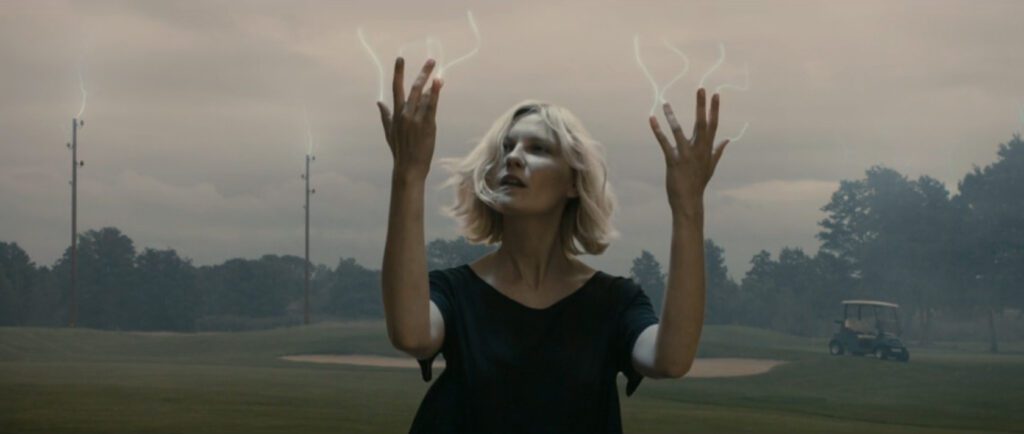
Melancholia
2011, directed by Lars von Trier
Let us entertain a notion about Melancholia so unlikely that however much evidence we find, most people would still dismiss it as coincidence. There is a lot of evidence, and it could be coincidental, but what matters in the end is the insight we can take away from the hypothesis.
There are reasons to think that Melancholia is a remake of a forgotten 1954 movie called The Naked Jungle, starring Charlton Heston and Eleanor Parker. Set on a cocoa plantation deep in the Amazon, the story is broken like Melancholia into two distinct halves, the first one about a marriage and the second about a force of nature that threatens to wipe everything out. The main characters are named Joanna and Christopher, “J” and “C” like Justine and Claire. The force of nature is called the Marabunta, not unlike the name of the planet Melancholia, and both come as surprises halfway through the story. Characters watch the Marabunta’s approach through binoculars, as they observe Melancholia through a telescope. Each of those destructive forces is heralded by birds deviating from their usual flight paths. Both movies are set in palatial houses isolated from larger society.
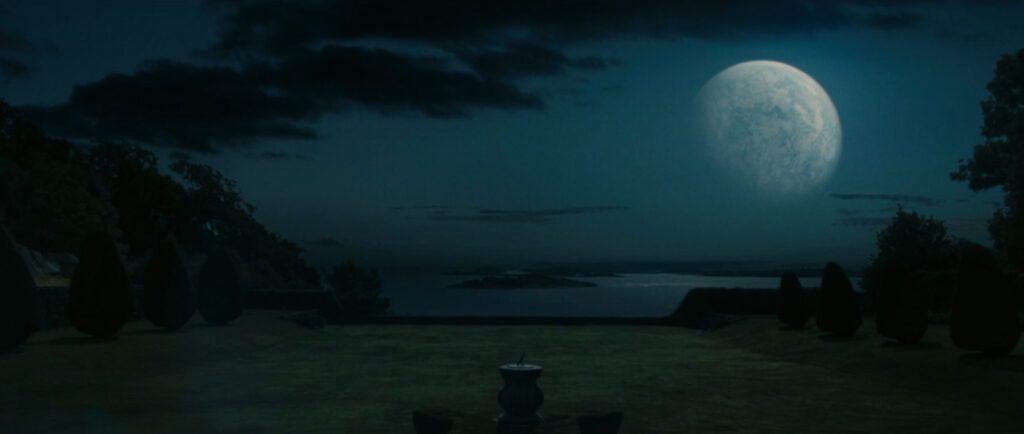
In The Naked Jungle Joanna tells her husband that if men and women go together, they’re like spoons; in Melancholia the father steals spoons from the dining table. In both films the husband hopes to make his wife happy with an orchard: either the cocoa plantation or Michael’s newly purchased apple orchard. The plantation house in one movie is filled with books of poetry, the mansion in the other is filled with books of art. Lastly, the choice of the star that foreshadows Melancholia’s arrival alludes to the identity of the Marabunta (which should remain nameless for those who have not yet enjoyed the surprise in The Naked Jungle).
Whether or not Lars von Trier had ever seen The Naked Jungle or intended to use it for a palimpsest, the similarities can help us to appreciate Melancholia. The force of nature in both movies is an extension of the emotions built up in the first half, but more than that it’s also a projection of the danger humankind poses to the whole planet. The threat to the Amazon in The Naked Jungle represents an early sign of ecological consciousness, and the threat to Earth in Melancholia is a warning about real dangers in our present world. To see these dangers more clearly we need to look closely at the movie’s characterization.
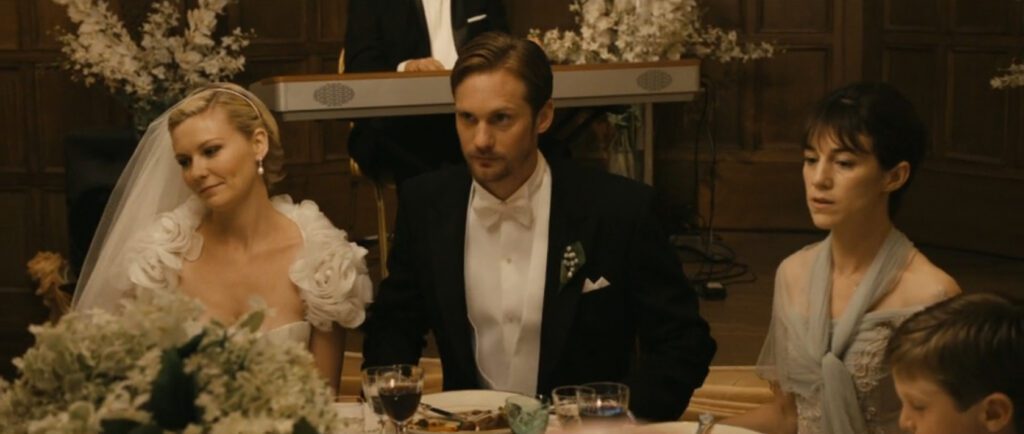
The two-part structure of Melancholia implies a contrast between the two sisters whose names label the respective halves. The order of the names is a puzzle – why should the second half be named for Claire, when Justine seems to dominate both halves? As it turns out, the contrast between Justine and Claire is a metonymy for the contrast between Justine and everyone else. Although she is surrounded by other people, in another sense Justine is profoundly alone through most of the movie.
In the middle of the wedding party everyone goes out on the lawn to launch balloons carrying messages of good will into the night sky. All the guests sign their names on the balloons or draw hearts or stars, but Justine draws a strange Picassoesque figure whose creativity stands out, even if it’s only onscreen for a second. We’re told that Justine is a creative person, and during the party she’s promoted to art director at Jack’s advertising firm. When she looks up during the balloon ceremony the film cuts to gorgeous images of colorful nebulae, as if she sees more beauty in the universe than anyone else.
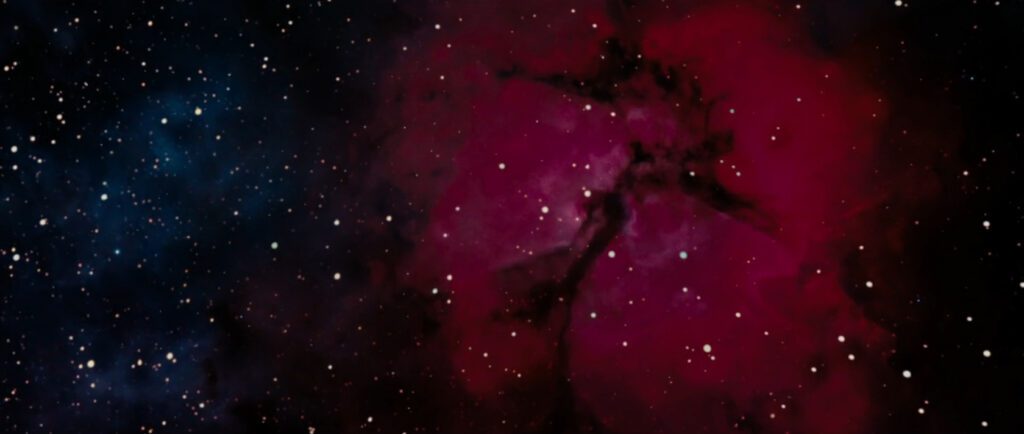
The movie does not go to excessive lengths to overwhelm us with Justine’s creative powers, and it’s just as well that it does not. However it systematically shows how thoroughly unimaginative everyone around her is. The groom’s speech is flagrantly unoriginal – “Dear Justine, um, bla bla bla bla bla…. I love you s-so much, and I-I never even dreamed that I would have such a-such a gorgeous wife.” Justine’s father makes mindless jokes the whole evening about the two Bettys beside him. John is a dull rationalist who keeps trying to impress Justine with the 18-hole golf course and the money he’s spent. Justine’s boss Jack is such a bore that he wants her to work on her wedding day, and his nephew Tim follows Justine around like a puppy trying to get the tagline from her. Justine’s mother wants her to run away, and the wedding planner and house servant “Little Father” are comically literal-minded and pedantic.
As the second protagonist, Claire embodies the lack of imagination we see in all the supporting characters. The ways she keeps nudging Justine to behave and be happy are the desperate efforts of someone who cannot find a way to cross into the other’s mind. When she wants her sister and Leo to light some candles and spend their last minutes on the terrace drinking and singing, Justine tells her the idea is “a piece of shit.” Justine’s “magic cave” may not seem that different from Claire’s plan, but it has the extra edge of imagination needed to make their last moments of life bearable. However the problem is not merely that Claire isn’t as creative as her sister. When Claire takes her aside 22 minutes in and tells her, surrounded by books of fine art, not to “make any scenes”, it’s a strange thing to say because up to that point Justine hasn’t acted up. Claire could just as well say the same thing to her parents… but we can also hear a double meaning. Painters, playwrights, actors, opera composers, and movie directors always “make scenes”, and in that sense Claire’s commanding her sister not to exercise her imagination.
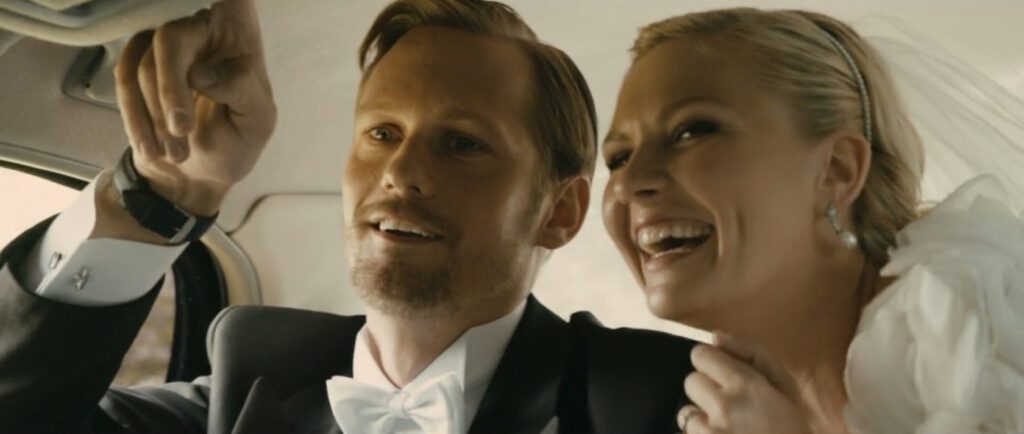
From this point of view, Justine’s depression is simply her response to a world that wants to stifle her creative personality. She doesn’t fit in the world, just as the limousine doesn’t fit in the driveway, and Justine’s body doesn’t fit through the door when Michael ceremoniously carries her into the bedroom. Of course things that don’t fit can be made to fit, but the result is usually disastrous, like when a planet is made to fit inside another planet. Justine’s marriage to Michael is a disaster because she can’t bring herself to fit with someone so unlike herself.
If we view Melancholia as a movie about the difficulties of living in a world where imagination is suppressed, its enigmas start to make sense. The 19th hole of the golf course is a picture of imagination exceeding the limits of reality. When Justine replaces the display of geometric artworks in the library with representational paintings, she’s replacing abstractions with life. When Justine tells Claire she knows things other people don’t, like the number of beans in the jar or whether we’re alone in the universe, it comes across as a gift of supernatural knowledge, but it also works as a metaphor for an expansive imagination. The name of Justine’s horse, Abraham, is trickier until we recall that the dog in Dogville was named Moses – Moses was a figure of judgment like the characters in Dogville, a man who delivered God’s commandments from a mountaintop, and Abraham is likewise a figure of creation, the progenitor of a great lineage and religious tradition.
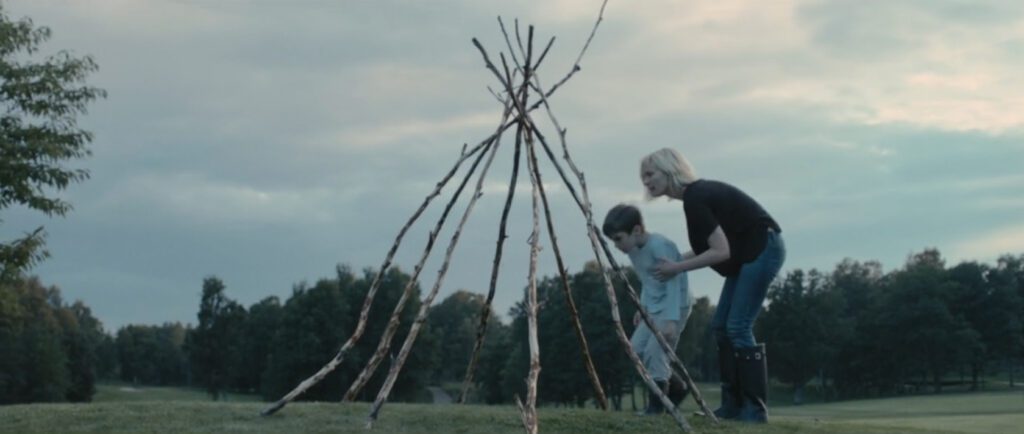
When Justine finally confronts Jack, telling him the best tagline would be “nothing” and that he and his firm are nothing, it would seem as if her imagination had reached its limits – but the point of the scene is that imagination does not mean creating something out of nothing, as Jack expects with his tagline. That would be playing God, which in von Trier’s movies is the original sin. Real creativity is making something better out of what already exists, like the magic cave, or the way Melancholia itself transforms and improves on The Naked Jungle. Leo asks Justine whether the cave is “something everybody can make,” and she replies, “Aunt Steelbreaker can.” The magic cave is nothing more than a few sticks arranged in a cone, but only an imaginative person would think of it. Her act of creativity may not halt the world’s destruction or save her family, but it protects them from agony, transforming a terrifying experience into a moment of wonder.
CONNECTIONS:
I Walked with a Zombie – Similarity to The Naked Jungle; siblings with American and British accents
The Naked Jungle – Two parts: marriage/force of nature; Melancholia/Marabunta; J&C; birds; house in the country; ants/Antares & Aunt; spoons; poetry books/art books; cocoa plantation/apple orchard
The Eighth Day of the Week – An ideal represented by a non-existent extra number: 8th day of the week, 19th hole of a golf course
Solaris – Allusion to Pieter Bruegel the Elder’s The Hunters in the Snow
Breaking the Waves – Wedding at the beginning; fault line of the film’s argument runs between two sisters or sisters-in-law who are nevertheless not entirely opposed; miracle or cataclysm in the sky at the end
Dancer in the Dark – Idea that creating something from nothing is a divine privilege not permitted to mortal artists
Dogville – Dog named Moses, horse named Abraham
Wild Tales – Bracketed by a collision with Earth and a disastrous wedding